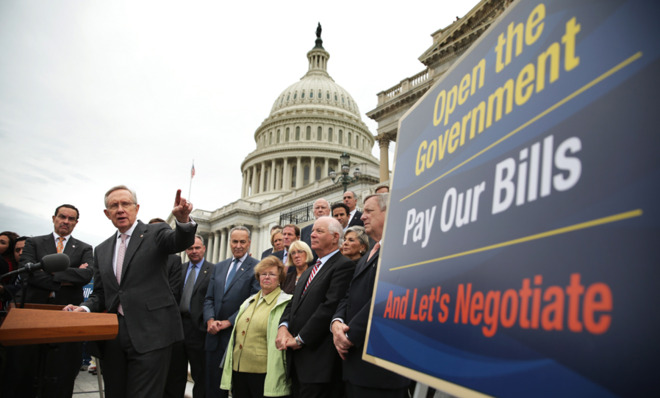Digital direct democracy is crushing representative democracy
Today, everyone has a voice in everything. That's not a good thing.


Ezra Klein's "13 reasons Washington is failing" deserves a read — and I say that as someone who most definitely does not agree with all his conclusions.
He rounds up the usual suspects: The end of earmarks, the Hastert rule not really being a rule, filibusters causing gridlock, etc. Klein also jumps on the conventional wisdom about the evils of gerrymandering (which largely ignores the fact that people are self-segregating along political lines.)
But that's not my primary beef. Instead, my main criticism is that Klein omitted a lot of other key factors.
The Week
Escape your echo chamber. Get the facts behind the news, plus analysis from multiple perspectives.

Sign up for The Week's Free Newsletters
From our morning news briefing to a weekly Good News Newsletter, get the best of The Week delivered directly to your inbox.
From our morning news briefing to a weekly Good News Newsletter, get the best of The Week delivered directly to your inbox.
Let me propose just one: The rise of direct democracy.
Complaining about too much democracy sounds crazy — almost as crazy as complaining about too much transparency (which Klein, in fact, does). But the surplus of democracy actually is a real problem, even if it sounds absurd.
It used to be that we elected representatives who would essentially serve as our trustees for a set period of time. Sure, they received constituent mail and phone calls and lobbyists visited them. And sure, they might occasionally see some polling numbers or a tough letter to the editor. And yes, on big votes, party leaders and bosses (now mostly impotent) would twist arms. But rank-and-file members generally could vote their conscience, knowing they wouldn't be called on the carpet until Election Day, which — depending on the office one held — was two to six years down the road.
This is not to say they weren't accountable. It's just that they would be held accountable at the appointed time. But until that time, they could largely act without fear or consideration of snap public opinion or too much immediate retribution. They were free to take a relatively long view of politics — to sometimes take unpopular stands.
A free daily email with the biggest news stories of the day – and the best features from TheWeek.com
Voters would have time to judge the totality of their tenure, and also to cool down.
This was by design. The founders, of course, feared direct democracy, and instead created a republic. The idea was to avoid a form of government susceptible to being swept up in the emotions of the day and subverting checks and balances. They wanted to avoid mob rule and the tyranny of the majority. But one gets the sense that their concerns might be playing out as we speak.
We don't have a direct democracy. Citizens do not (yet) log onto the internet and directly cast votes on things. Some states have Progressive-era reforms like voter initiatives, referendums, and recalls (which are to blame for much dysfunction in places like California), but that's not what I'm talking about.
We still have elected officials, and they still must stand for re-election at the appointed time. But the amount of information and input they receive from constituents and interest groups and basically anyone anywhere in the world who has an opinion on something makes it almost impossible for them to ignore the stimuli. Today's politicians must feel more like American Idol contestants who survive by constantly seeking our approval than statesmen who are empowered to take tough stances.
With Twitter, email, constant polling, and 24-hour cable news, our leaders must forever be at the beck and call of their constituents and pundits, and that's not as salutary as it sounds. Everyone might not get to vote on everything, but they have a giant megaphone with which to weigh in. And that digital version of direct democracy is undermining our representative democracy.
Matt K. Lewis is a contributing editor at TheWeek.com and a senior contributor for The Daily Caller. He has written for outlets including GQ Politics, The Guardian, and Politico, and has been cited or quoted by outlets including New York Magazine, the Washington Post, and The New York Times. Matt co-hosts The DMZ on Bloggingheads.TV, and also hosts his own podcast. In 2011, Business Insider listed him as one of the 50 "Pundits You Need To Pay Attention To Between Now And The Election." And in 2012, the American Conservative Union honored Matt as their CPAC "Blogger of the Year." He currently lives in Alexandria, Va.
-
 Heavenly spectacle in the wilds of Canada
Heavenly spectacle in the wilds of CanadaThe Week Recommends ‘Mind-bending’ outpost for spotting animals – and the northern lights
-
 Facial recognition: a revolution in policing
Facial recognition: a revolution in policingTalking Point All 43 police forces in England and Wales are set to be granted access, with those against calling for increasing safeguards on the technology
-
 Codeword: December 14, 2025
Codeword: December 14, 2025The daily codeword puzzle from The Week
-
 Has Zohran Mamdani shown the Democrats how to win again?
Has Zohran Mamdani shown the Democrats how to win again?Today’s Big Question New York City mayoral election touted as victory for left-wing populists but moderate centrist wins elsewhere present more complex path for Democratic Party
-
 Millions turn out for anti-Trump ‘No Kings’ rallies
Millions turn out for anti-Trump ‘No Kings’ ralliesSpeed Read An estimated 7 million people participated, 2 million more than at the first ‘No Kings’ protest in June
-
 Ghislaine Maxwell: angling for a Trump pardon
Ghislaine Maxwell: angling for a Trump pardonTalking Point Convicted sex trafficker's testimony could shed new light on president's links to Jeffrey Epstein
-
 The last words and final moments of 40 presidents
The last words and final moments of 40 presidentsThe Explainer Some are eloquent quotes worthy of the holders of the highest office in the nation, and others... aren't
-
 The JFK files: the truth at last?
The JFK files: the truth at last?In The Spotlight More than 64,000 previously classified documents relating the 1963 assassination of John F. Kennedy have been released by the Trump administration
-
 'Seriously, not literally': how should the world take Donald Trump?
'Seriously, not literally': how should the world take Donald Trump?Today's big question White House rhetoric and reality look likely to become increasingly blurred
-
 Will Trump's 'madman' strategy pay off?
Will Trump's 'madman' strategy pay off?Today's Big Question Incoming US president likes to seem unpredictable but, this time round, world leaders could be wise to his playbook
-
 Democrats vs. Republicans: who are US billionaires backing?
Democrats vs. Republicans: who are US billionaires backing?The Explainer Younger tech titans join 'boys' club throwing money and support' behind President Trump, while older plutocrats quietly rebuke new administration
